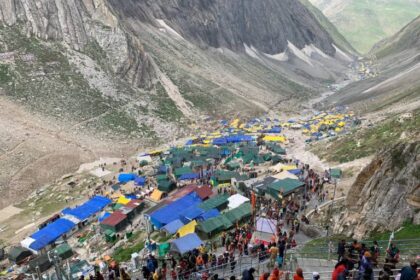Militancy Surge Threatens Kashmir’s Tourism Revival and Local Livelihoods
The return of violence in North Kashmir jeopardizes the ceasefire-fueled tourism boom, disrupting local economies and eroding fragile cross-border goodwill.
||Black and White Digital News ||
||Parvinder Singh August 19,2024 ||
Srinagar :The surge in militancy in North Kashmir’s border regions is casting a long shadow over the tourism industry that had been flourishing since the February 2021 ceasefire agreement between India and Pakistan. This resurgence threatens not only the safety of visitors but also the livelihoods of local communities who had begun to see the benefits of a more peaceful environment.
Tourism Boom in Jeopardy:
The 2021 ceasefire had opened up previously off-limits regions to tourists, sparking interest in high-altitude adventure circuits and picturesque villages near the Line of Control (LoC). Keran, Machil, and other areas, once synonymous with conflict, had started attracting tourists keen on experiencing the rugged beauty of these remote locales. The Indian Army’s relaxation of travel restrictions and the promotion of these areas as tourist destinations brought a wave of economic opportunities for the local population.
However, the rise in militant activity has abruptly halted this progress. The recent encounters between security forces and militants in the Kupwara district, particularly the killing of infiltrators in the Keran Sector, have led to a re-imposition of strict travel restrictions. The Jammu and Kashmir administration, which had earlier streamlined the process of obtaining travel passes, is now enforcing a more rigorous vetting procedure. The ease with which tourists could once explore these regions has been replaced by stringent security protocols, requiring prior online permissions that are difficult to obtain.
Economic Impact on Local Communities:
For the local communities, this return to violence is devastating. Residents who had begun to see tourism as a viable source of income now face an uncertain future. Homestay businesses, small eateries, and local guides, who had all benefited from the influx of visitors, are now dealing with cancellations and a significant drop in tourist numbers. The economic ripple effect is felt across the region, from small traders to transport operators, all of whom had hoped that the peace would bring sustained prosperity.
Military and Strategic Implications:
The security forces’ response to the increasing militant activities has been swift and decisive, with intensified patrols and operations in the affected areas. However, this also means that many tourist circuits, including popular off-roading routes, have been shut down for the foreseeable future. The closure of the Machil-Zamindari Gali-Razdan Top circuit is particularly disappointing for adventure tourists, who had flocked to the region for its challenging terrain and stunning landscapes.
Moreover, the situation has strained the already fragile relationship between India and Pakistan. The Pakistani Army’s use of public address systems to discourage Indian tourists from approaching the Neelum River signifies a hardening of attitudes along the border. This development is particularly disheartening given the cross-border interactions that had flourished in recent years, with tourists on both sides engaging in spontaneous displays of camaraderie.
The Human Cost of Renewed Conflict:
The renewed violence is a stark reminder of the region’s vulnerability to geopolitical tensions. For the residents of North Kashmir, the return of militancy is not just a security concern but a deeply personal setback. The hope that had been kindled by the ceasefire agreement and the subsequent tourism boom is now being replaced by fear and uncertainty. Many fear that the region will once again be relegated to the status of a conflict zone, with all the associated hardships.
Looking Ahead: The Need for a Balanced Approach:
As the situation unfolds, there is a pressing need for a balanced approach that addresses both security concerns and the aspirations of the local population. While the safety of tourists and residents must remain a priority, efforts should also be made to preserve the gains made in the tourism sector. This could involve exploring alternative tourism models that are less vulnerable to security disruptions or providing economic support to those affected by the decline in tourism.
The resurgence of militancy in North Kashmir serves as a stark reminder of the challenges that continue to beset the region. It underscores the fragility of peace and the ease with which progress can be undone. As the authorities work to contain the threat, it is essential to keep in mind the human and economic costs of renewed conflict, and to strive for solutions that promote long-term stability and development.
@topfans
@









